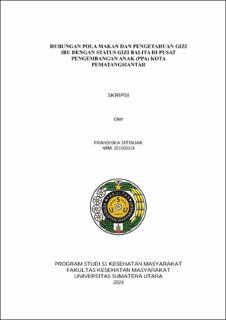Hubungan Pola Makan dan Pengetahuan Gizi Ibu dengan Status Gizi Balita di Pusat Pengembangan Anak (PPA) Kota Pematangsiantar
The Relationship of Eating Patterns and Nutritional Knowlegde with Nutritional Status of Toddlers in Child Development Center Pematangsiantar City

Date
2024Author
Sitinjak, Fransiska
Advisor(s)
Aritonang, Evawany Yunita
Metadata
Show full item recordAbstract
Nutritional status is a measure of a person's success in fulfilling nutrition as indicated by body weight and height. Eating patterns and nutritional knowledge influence the nutritional status of toddlers. Eating patterns has a big influence on nutritional status because choosing inappropriate, unhealthy foods and excessive or insufficient amounts will also cause nutritional problems. Good maternal knowledge about nutrition will make it easier for mothers to care for their children, especially paying attention to their children's food intake so that their children's nutritional status is good. The purpose of this research was to determine the relationship of eating patterns and nutritional knowledge with nutritional status of toddlers in Child Development Center Pematangsiantar City. This type of research is quantitative observational research using a cross sectional design. The population in this study were all toddlers at the Grace Child Development Center and Immanuel Child Development Center, totaling 55 toddlers. The sampling technique used total sampling, so the sample in this study was 55 toddlers. Diet patterns were taken using a 24 hour food recall form. Maternal nutritional knowledge was taken using a questionnaire. Nutritional status uses anthropometric measurements by measuring body height and weight. The results of this study show that there is no relationship between eating patterns and the nutritional status of toddlers (p= 0.288) and there is a relationship between maternal nutritional knowledge and the nutritional status of toddlers (p= 0.023). It is recommended for mothers of toddlers to pay attention to their children's eating patterns so that they are given a variety of food ingredients starting from the diversity of food intake, the form of food given according to age, and the frequency of eating so that children can grow and develop optimally
Collections
- Undergraduate Theses [3186]
